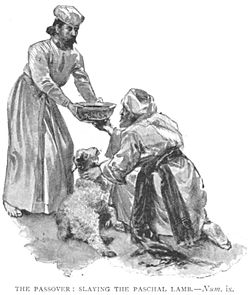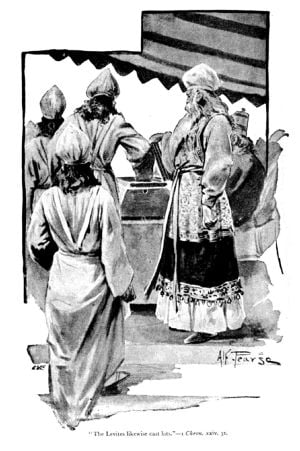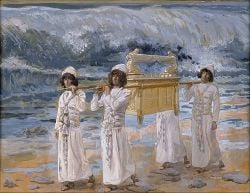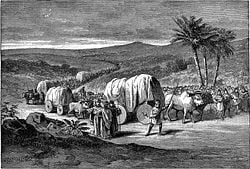Levite

A Levite (from Levi, "attached") is a member of the Hebrew tribe of Levi in the Jewish tradition. The Levites served as assistants to the sons and descendants of the first chief priest, Aaron, at the Tabernacle in the wilderness and later at the Temple of Jerusalem.
When the Israelites entered the land of Canaan, the Levites received no tribal land. Instead, they attended local altars, supervised cities of refuge, and served as judges and educators. In return, the members of the landed tribes were expected to give tithes to the Levites and to provide them with local pastures on which to graze their own cattle.
A movement to centralize Levitical activity in Jerusalem was initiated by King Josiah of Judah in the late seventh century B.C.E. After the Babylonian exile, the Levites were instrumental in the rebuilding of the Temple and became a mainstay in the mature Jewish tradition. After the destruction of the Temple in 70 C.E., their role diminished greatly. Many Jews continue to identify themselves as Levites today.
In the Bible
The Levites are named after Levi, the third son of Jacob, through Leah. Together with his brother Simeon, Levi avenged the rape of their sister Dinah by murdering the male residents of Shechem after the Shechemites had been circumcised as a condition for their prince—who had earlier defiled Dinah—to marry into Jacob's family. For this, the brothers were criticized and later cursed by their father for "making me a stench to the Canaanites and Perizzites, the people living in this land" (Gen. 34:30). Levi himself had three sons: Gershon, Kohath, and Merari (Gen. 46:11). Kohath's son Amram was the father of Miriam, Aaron and Moses.
The descendants of Aaron—the Kohanim—had a special role as priests of the Tabernacle in the wilderness and later in the Temple of Jerusalem. The other Levites were not allowed to minister directly at the altar of the central shrine, but assisted the Kohanim in various other ways. They were divided into three groups based on their ancestral lineage: the Gershonites, the Kohathites, and the Merarites. Each division filled different roles in the Tabernacle and later in the Temple services.
Origins of the Levitical office
Beside their obvious tribal connection to the family of Moses and Aaron, the Levites were chosen for the special role because of their loyalty after the affair of the golden calf (Exod. 32:25-29):
Moses saw that the people were running wild and that Aaron had let them get out of control and so become a laughingstock to their enemies. So he stood at the entrance to the camp and said, "Whoever is for the Lord, come to me." And all the Levites rallied to him. Then he said to them, "This is what the Lord, the God of Israel, says: 'Each man strap a sword to his side. Go back and forth through the camp from one end to the other, each killing his brother and friend and neighbor.'" The Levites did as Moses commanded, and that day about three thousand of the people died. Then Moses said, "You have been set apart to the Lord today, for you were against your own sons and brothers, and he has blessed you this day."
Nevertheless, some of the Levites later rebelled against the system which gave exclusive rights to Aaron's descendants to attend the Tabernacle altar. Their leader, Korah, a Kohathite, declared to Moses and Aaron: "You have gone too far! The whole community is holy, every one of them, and the Lord is with them. Why then do you set yourselves above the Lord's assembly?"
For their untimely attempt to democratize the priesthood, these Levites and their families were put to death directly by Yahweh himself:
The ground under them split apart and the earth opened its mouth and swallowed them, with their households and all Korah's men and all their possessions. They went down alive into the grave, with everything they owned; the earth closed over them, and they perished and were gone from the community. (Numbers 16:31-33)
Those Levites who remained loyal to Moses and Aaron, however, continued to be blessed by God with a special status apart from that of the other Israelites. The Levites' sacred role is mentioned in various passages of the Torah and especially in the Books of Chronicles, Ezra, and Nehemiah. The first chapters of the Book of Numbers, after enumerating the functions of the sons of Aaron, states: "Bring the tribe of Levi and present them to Aaron the priest to assist him. They are to perform duties for him and for the whole community at the Tent of Meeting by doing the work of the tabernacle... Appoint Aaron and his sons to serve as priests; anyone else who approaches the sanctuary must be put to death."
The Levites were consecrated to this service in ceremonies described in Numbers 8:5-22. Then also had the duty of carrying the Tabernacle and its utensils and to keep guard about the sanctuary lest any unauthorized person should infringe on its sacred confines. They were allowed to perform their functions only after reaching 30 years of age.
After entering Canaan
In the distribution of the land of Canaan, the Levites did not receive an allotment of land as did the other tribes. Instead, they were to supervise "cities of refuge" (places where people who had committed manslaughter could go to avoid blood vengeance from the family of their victim) and serve as priests and teachers at local shrines throughout the land until a central sanctuary would be created. Genesis 49:5-7, however, indicates a different reason for the Levite's dispersal, relating back to their ancestor's violent act in regard to the Shechemites:

- Simeon and Levi are brothers—their swords are weapons of violence.
- Let me not enter their council, let me not join their assembly,
- for they have killed men in their anger and hamstrung oxen as they pleased.
- Cursed be their anger, so fierce, and their fury, so cruel!
- I will scatter them in Jacob and disperse them in Israel.
The prevailing explanation, however, is that the Levites were set aside to play a positive and essential role attending the high places and other local altars to Yahweh, since no central shrine yet existed. In the words of Joshua 13:33: "To the tribe of Levi, Moses had given no inheritance; the Lord, the God of Israel, is their inheritance, as he promised them."
To provide for their livelihood, the Levites received tithes of the local harvests and cattle: "I give to the Levites all the tithes in Israel as their inheritance in return for the work they do while serving at the Tent of Meeting" (Num. 18:21). They also received pasturelands on which to graze their own herds (Josh. 21). The Levitical system is described in much detail in the Pentateuch, Joshua, and the Books of Chronicles. Although portrayed as originating with Moses, most scholars agree that the system was in fact the result of a long process of development.
The principle Levite roles in the Temple included singing psalms during Temple services, performing construction and maintenance for the Temple, serving as guards, and assisting the Kohanim in their priestly duties. Levites also served as teachers and judges, maintaining cities of refuge in Biblical times.
During the period of kings
The biblical account tells of several movements in which the Levites played an important role in educating the local population and supporting the Aaronic priests’ functions of the Temple of Jerusalem. Chronicles describes the Levites as siding with the southern king Rehoboam of Judah against the new northern Kingdom of Israel under Jeroboam I: "The Levites even abandoned their pasturelands and property, and came to Judah and Jerusalem because Jeroboam and his sons had rejected them as priests of the Lord" (2 Chron. 11:4). King Jehoshaphat of Judah reportedly sent Levites out to teach the law of Moses to the population (2 Chron. 17). Later, he appointed some of them as judges in Jerusalem under the chief priest Amariah (2 Chron. 19). The later high priest Jehoiada was supported by Levites in his violent coup against the pro-Baalist Queen Athaliah of Judah, successfully establishing the boy-king Joash on the throne in her place (2 Chron. 24).
Levites were also essential in King Hezekiah's reform of purging the Temple of Jerusalem of allegedly idolatrous furnishings (2 Chron. 29), probably including the bronze serpent which Moses had made (2 Kings 18:4).
A particularly important centralizing reform took place several generations later under King Josiah (late sixth century B.C.E.). According to 2 Kings 22:
Josiah brought all the priests from the towns of Judah and desecrated the high places, from Geba to Beersheba, where the priests had burned incense. He broke down the shrines at the gates—at the entrance to the Gate of Joshua, the city governor, which is on the left of the city gate. Although the priests of the high places did not serve at the altar of the Lord in Jerusalem, they ate unleavened bread with their fellow priests.
The reform is thought by most modern scholars to conform to regulations regarding the Levites given in the Book of Deuteronomy, usually considered to have been written during Josiah's reign. It warns: "Be careful not to sacrifice your burnt offerings anywhere you please. Offer them only at the place the Lord will choose in one of your tribes, and there observe everything I command you" (Deut. 12:12-14). It also encourages the Levites to move to Jerusalem by offering them equal benefits with those who had earlier come to the capital:
If a Levite moves from one of your towns anywhere in Israel where he is living, and comes in all earnestness to the place the Lord will choose, he may minister in the name of the Lord his God like all his fellow Levites who serve there in the presence of the Lord. He is to share equally in their benefits, even though he has received money from the sale of family possessions. (Deut. 18:6-8)
After the exile
While Josiah's reforms did not last past his own reign, after the Babylonian exile, they became the basic standard of Jewish tradition. Levites no longer offered sacrifices at local shrines and high places, but served only in Jerusalem as assistants to the official priesthood. The Book of Chronicles, written shortly after the return from Babylon, particular emphasizes the role of these "Levite priests." The Book of Ezra reports that the Levites were responsible for the construction of the Second Temple and also translated and explained the Torah to the people when it was publicly read.
Levites are mentioned three times in the New Testament (Luke 10:32; John 1:19; Acts 4:36). However, these references shed little light on their role during the period in question.
After the fall of the Temple of Jerusalem, the Levites, like the official Aaronic priests, diminished quickly in significance. The rabbinical movement of the Pharisees, meanwhile, rose to prominence and became the primary spiritual authority of the Jewish community through the development of the Talumdic tradition. Some among the Orthodox community still hope for a restoration of the Levites and Kohamim, which would be contingent on the rebuilding of the Temple, without which their role is essentially mooted.
Critical views
The process by which the Levites came to fulfill their function as assistants to the Aaronic priesthood is the subject of much scholarly debate. Biblical literalists insist that the history of the Levites is just as the Bible describes it: they served the sons of Aaron in the wilderness in the days of the Tabernacle; they settled among the diverse tribes after the conquest of Canaan; and they gradually came to Jerusalem after the establishment of the Temple. Some biblical critics agree with this basic scenario, adding mainly that centralization of the Levites in Jerusalem was not necessarily a voluntary matter. Indeed, the Books of Kings seem to describe a situation in which those who refused to stop offering sacrifices at local altars would face serious consequences.
Others believe that the Levites only gradually developed as a second-tier priesthood in Jerusalem and that their biblical history was created after the fact to suit the situation of later times. Deuteronomy in particular appears to provide a backdated law "of Moses" describing the reforms of King Josiah's era. The Books of Chronicles similarly portray a well defined role for the Levites during the period of the kings, while in the earlier Books of Kings their role is hardly mentioned.
Some suggest that the Levites may in fact have been local rivals to the Jerusalem priesthood who for centuries resisted the Temple's claim to be the only authorized sanctuary of Yawheh. It could also be that the reason for the Levites' not receiving an inheritance with the other tribes is that they were actually already living in the land when the Aaronic priesthood migrated to Canaan. In this scenario they would represent the native proto-Israelite traditions of worship at local shrines and high places, while the Aaronic priesthood represented the "Jerusalem only" tradition. Some also question the account in Chronicles which portrays the northern Levites as defecting en masse to Rehoboam after Jeroboam's schism. The story of the Levite of Judges 17-18 indicates strong Levite involvement at the northern shrine at Dan, for example, while the story of Korah's rebellion indicates longstanding tension between the more democratic Levites and the elitist Aaronic priests (Num. 16). Northern Levites who did not move to Jerusalem may have been among those who later served as priests to the Samaritans.
In contemporary Judaism
Because genealogical records dating back to biblical times do not exist, Levitical status is generally determined by oral tradition, passed from father to son, with children being Levites if their father and grandfather were. However, it is difficult to know if all those who claim Levitical status are true Levites, and many who might hold that status genetically are unable to claim it because one generation may have failed to pass the status on to the next for various reasons.
Levitical names
Although the vast majority of Jews did not adopt surnames until the modern era, many have taken a last name to signify their supposed status as Levites. Because of diverse geographical locations, the names have several variations:
- Levi, Lévy - Hebrew for "Levite," equally common in Ashkenazic and Sephardic groups
- HaLevi, Halevi and Halevy are Hebrew language and all translate to "the Levi" or "the Levite"
- Levin - a Russian variation, also Levine or Lavine and Lewin, a Polish variation. Sometimes this name is supplemented with German 'thal' (valley) to Levinthal or Leventhal and -sohn and -son to Levinson or Levinsohn. With the slavic -ski and -sky suffixes, this becomes Levinski, Levinsky, Lewinski and Lewinsky.
- Lewitas, Levitas are common Belarusian derivatives
- Variants from yiddish include Levicz, Levis, Levitz, Lewicz, Lewitz, Lewis, Leviczky, Levitski, Levitsky, Lewitski, etc.
- Loewy, Löwi, Löwy, and Loewe German or Swiss variations (although the usual origin for these names is Loewe, the German word for "lion"). Leevi is a Finnish variation.
Having a last name related to Levi, however, does not necessarily mean a person is a Levite, and many Levites do not have such last names. In traditional Judaism, tribal status is determined by patrilineal descent, so a child whose biological father is a Levite is a Levite. In cases of adoption or artificial insemination, status is determined by the genetic father. Because Jewish status is traditionally determined by matrilineal descent, conferring levitical status on children requires both biological parents to be Jews and the biological father to be a Levite.
Some Jewish names that sound like Levi may or may not be intentionally related to the name. Examples include Love, which may be an anglicized version of Loewe, and Levant, which relates to the Levantine area of the Middle East.
The Jewish names Cohen, Kahn', Cohn, and similar names denote a supposed descent from the Kohanim, or Aaronic priests.
Rights and duties
Today, Levites in Orthodox Judaism have certain rights and obligations, although these responsibilities have diminished greatly because of the destruction of the Temple. For instance, Levites are eligible to be called to the Torah before the general congregation, but after the Kohanim. In some congregations, the Levites also provide assistance to the Kohanim, particularly washing their hands, before the Kohanim recite the Priestly Blessing. They also do not participate in the Pidyon Haben[1] (redemption of the firstborn) ceremony, because they are traditionally pledged to Divine service.
Conservative Judaism theoretically recognizes Levites as having special status, but not all Conservative congregations call Kohanim and Levites to the first and second reading of the Torah, and many no longer perform rituals such as the Priestly Blessing and Pidyon Haben, in which the priestly classes has a special role. Reconstructionist and Reform Judaism have generally abolished all Biblical caste distinctions.
Many adherents of Orthodox Judaism believe in the eventual rebuilding of a Temple in Jerusalem and a resumption of the Levitical role. Some have even founded schools to train priests and Levites in their respective roles. Some Conservative Jews also believe in a future restoration of the Temple and in some special role for Levites, although not the ancient sacrificial system as previously practiced. Reform and Reconstructionist Judaism generally do not hope for a future physical Temple, believing that God's covenant is fully present without it.
Bat Levi
A Bat Levi (daughter of a Levite) is recognized as having lineal sanctity in both Orthodox and Conservative Judaism, stemming from her traditional eligibility to receive proceeds of the Levitical tithe. In both Orthodox Judaism and Conservative Judaism, children of a Bat Levi, regardless of her marital status or husband's tribe, retain their traditional exemption from the requirement of being redeemed through the Pidyon HaBen ceremony because of this lineal sanctity.
Conservative Judaism permits a Bat Levi to perform essentially all the rituals a male Levi would perform in those Conservative synagogues which have both retained traditional tribal roles and modified traditional gender roles.
Notes
- ↑ Originally the firstborn were supposed to be dedicated to the Temple, but the Levites were dedicated instead, and the Israelites had to pay a half shekel or so in order to "redeem" their first born sons from this duty. Some scholars think the firstborn in very ancient times had to be "redeemed" from being literally offered as human sacrifices.
ReferencesISBN links support NWE through referral fees
- Brown, William. Tabernacle and Its Priests and Services. Whitefish, MT: Kessinger Publishing, 2003. ISBN 978-0766165915
- Kaganoff, Benzion C. A Dictionary of Jewish Names and Their History, new ed., 1996. Jason Aronson. ISBN 978-1568219530
- Miller, Patrick D. The Religion of Ancient Israel. Louisville, KY: Westminster John Knox Press, 2000. ISBN 978-0664221454
- O'Brien, Julia M. Priest and Levite in Malachi. Scholars Press, 1991. ISBN 978-1555404383
External links
All links retrieved March 11, 2025.
- Levites – Catholic Encylopedia
- What is a Levite? – AskMoses.com
Credits
New World Encyclopedia writers and editors rewrote and completed the Wikipedia article in accordance with New World Encyclopedia standards. This article abides by terms of the Creative Commons CC-by-sa 3.0 License (CC-by-sa), which may be used and disseminated with proper attribution. Credit is due under the terms of this license that can reference both the New World Encyclopedia contributors and the selfless volunteer contributors of the Wikimedia Foundation. To cite this article click here for a list of acceptable citing formats.The history of earlier contributions by wikipedians is accessible to researchers here:
The history of this article since it was imported to New World Encyclopedia:
Note: Some restrictions may apply to use of individual images which are separately licensed.


